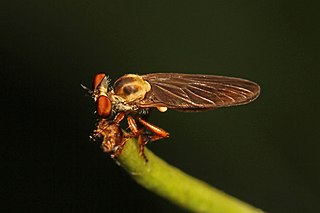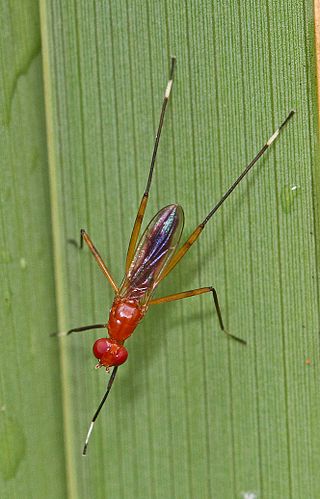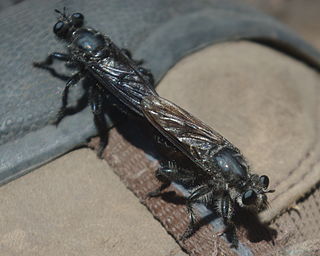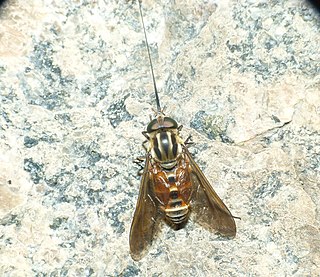
The Lauxaniidae are a family of acalyptrate flies. They generally are small flies with large compound eyes that often are brightly coloured in life, sometimes with characteristic horizontal stripes, such as in Cestrotus species. Many species have variegated patterns on their wings, but in contrast they generally do not have variegated bodies, except for genera such as Cestrotus, whose camouflage mimics lichens or the texture of granitic rocks.

Rutilia is a large genus of medium to large (>20mm) flies in the family Tachinidae native to Australia and the Oriental region, though notably absent from New Zealand. Like the vast majority of tachinid flies, Rutilia species are parasitoids of other insects, specifically Rutilia are known to be parasitoids of late instar larvae of scarab beetles.

Platystomatinae is a subfamily of flies (Diptera) in the family Platystomatidae that includes 80 genera, the largest subfamily with at last estimate, c. 900 species globally.

Elassogaster is a genus of scavenger flies (Diptera) belonging to the family Platystomatidae. They are native to warm regions of Africa, Madagascar, Asia and Australia.

Cyphomyia is a genus of flies in the subfamily Clitellariinae.

Holcocephala is a genus of robber flies in the family Asilidae. There are at least 40 described species in Holcocephala.

Grallipeza is a genus of stilt-legged flies in the family Micropezidae. There are at least 40 described species in Grallipeza.
Maira is a genus of robber flies in the family Asilidae. There are at least 50 described species in Maira.

Anastoechus is a genus of bee flies. There are at least 90 described species in Anastoechus.

Pogonosoma is a genus of robber flies. There are about 17 described species in Pogonosoma.
Lampria is a genus of robber flies in the family Asilidae. There are at least 20 described species in Lampria.

Archilestris is a genus of robber flies in the family Asilidae. There are about six described species in Archilestris.

Triorla is a genus of robber flies in the family Asilidae. There are about five described species in Triorla.

Sparnopolius is a genus of bee flies, insects in the family Bombyliidae. There are about 17 described species in Sparnopolius.

Curtonotum is a genus of flies in the family Curtonotidae. There are more than 50 described species in Curtonotum.
Odontomera is a genus of flies in the family Richardiidae. There are about 19 described species in Odontomera.

Philoliche is a genus of long-tongued horse-flies found in the Old World. It is placed in the tribe Philolichini. The clade is thought to have originated about 40 million years ago and the 120 or more species are thought to have originated in Africa and expanded into Asia. The plants that they pollinate tend to have elongate corolla tubes.
















